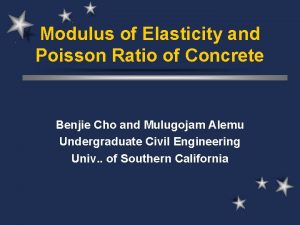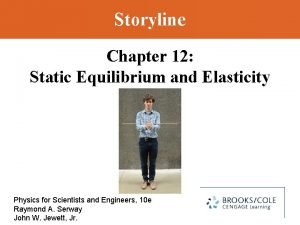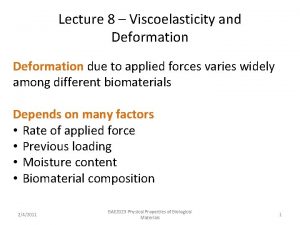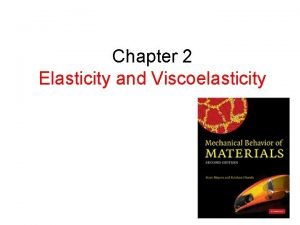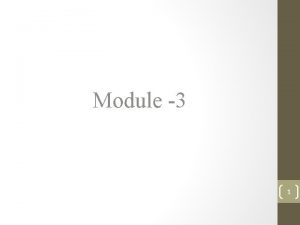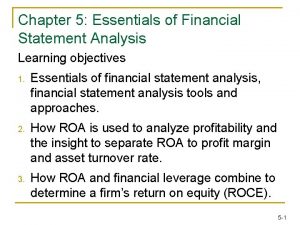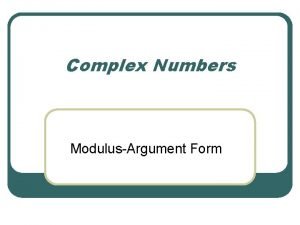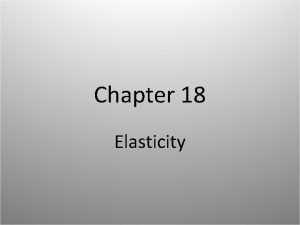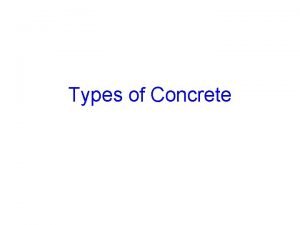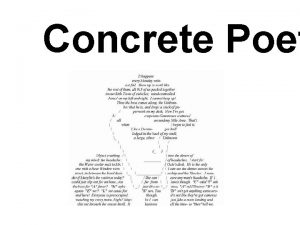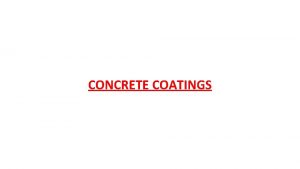Modulus of Elasticity and Poisson Ratio of Concrete


















- Slides: 18

Modulus of Elasticity and Poisson Ratio of Concrete Benjie Cho and Mulugojam Alemu Undergraduate Civil Engineering Univ. . of Southern California

Objective Find the Modulus of Elasticity of Concrete l Find Poisson’s Ratio of Concrete l

Introduction l Compressive Strength of Concrete – Standardardized test of concrete l American Society for Testing and Materials (ASTM) – Specifications include l Correct mix l Properly affixing strain gauges l Properly capping the cylinder with sulfur

Procedure Select (5) 4 in diameter by 12 in length concrete with 28 -day age with 4 ksi design strength. l Cap all the bearing surfaces with sulfur to make the end flat. l Mark area where strain gauges will be attached. l Clean area with chemical cleaners and sand paper. l

Procedure l l l Affix strain gauges on their designated area, one vertical and one horizontal, using glue. Attach wire to strain gauges by soldering. Test voltage of the strain gauges. Place and center samples on the Satec Universal Testing Machine. Connect the wires to the P 3500 strain indicator, which in turn is connected to a computer for recording.

Procedure Set gauge factor to 2. 055 +/-. 5% and zero the strain readings. l Begin loading the specimens and record values of strain for given loads. l Continue testing until failure of the specimen. l

Organizing the data Compute the stress by dividing the load by the cross-sectional area. l Graph the strength against the vertical and horizontal strains of each specimen. l Find values for the Young’s Modulus and Poisson’s ratio from the data. l Calculate theoretical values the Young’s Modulus and Poisson’s ratio. l

Calculation procedures l Young’s Modulus – E=(s 1 -s 2)/(e 2 -. 000005) l s 1=The stress corresponding to the longitudinal strain of 50 micro strain. l s 2=The stress corresponding to. 4 f ‘c. l E 2=The longitudinal strain corresponding to s 2. l Based on ASTM C 469 l Poisson’s Ratio – n=(Lateral Strain)/(Longitudinal Strain)

Example

Cylinder #2

Cylinder #3

Cylinder #4

Cylinder #5

Selected Values of Stress and Strain

Selected Values of Stress and Strain

Data

Conclusion All specimens performed under theorectical values of E. – Average E= 2. 60 E 6 psi l Average Poisson Ratio=. 119691 l

Conclusion l Concrete performed to design specifications. – E= 1. 5 - 5 ksi – n=. 1 l Xiao, Yan. Experimental Analysis of Engineering Materials. University of Southern California lecture notes 2002.
 Maximum value of poisson ratio
Maximum value of poisson ratio Douglas fir elastic modulus
Douglas fir elastic modulus Elasticity modulus
Elasticity modulus Poisson ratio for incompressible material
Poisson ratio for incompressible material Poisson ratio
Poisson ratio Hooke's law for stress and strain
Hooke's law for stress and strain Informal inventory
Informal inventory Concrete semi concrete abstract
Concrete semi concrete abstract High performance concrete
High performance concrete Concrete mixture ratio
Concrete mixture ratio 1:2:3 concrete
1:2:3 concrete Concrete grade table
Concrete grade table Fc and fc' concrete
Fc and fc' concrete Concrete mixture ratio
Concrete mixture ratio What is gel space ratio
What is gel space ratio Acid test ratio and quick ratio
Acid test ratio and quick ratio Genotypic ratio and phenotypic ratio
Genotypic ratio and phenotypic ratio Current ratio and quick ratio
Current ratio and quick ratio Modulus of a complex number
Modulus of a complex number
